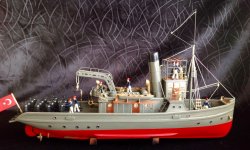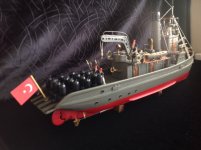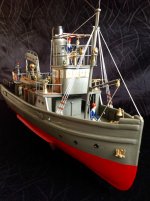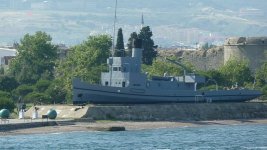PolarBear
Major
- Joined
- Feb 24, 2007
- Messages
- 6,706
Cem's finished model with crew.
Truly terrific work :salute:::salute:::salute:::salute:::salute::
WW1 Ottoman Minelayer Nusret Gallipoli Turkey
Text from http://www.spiritofremembrance.com/page/ww1-minelayer-nusret-gallipoli-turkey
Few warships have had as great an impact on the history of 20th Century naval warfare as the little Ottoman Navy minelayer Nusret.
She was built in Kiel, Germany in 1911 and commissioned into the Ottoman Navy in 1913, skippered by Lieutenant Tophaneli Hakki. On March 7, 1915 a few minutes after midnight, Nusret left the port of Canakkale. In a complete silence and darkness, she slipped down through the previously laid minefields. With the help of the pilot Captain Nazmi, she passed through Karanlik Liman and laid her complete load of twenty-six mines parallel to the Asiatic shore, The mines had been laid to catch the Allied warships as they turned to starboard after bombarding the Ottoman batteries and forts. At 13:54, the French battleship Bouvet—turned to starboard into Eren Köy Bay—struck a mine, capsized and sank within a couple of minutes, killing 600 men.
The initial British reaction was that a shell had struck her magazine or she had been torpedoed. Then at 16:16 the pre-Dreadnaught battleship HMS Irresistible was badly damaged when she struck one of the mines. Loss of life was mercifully low but eventually the drifting and abandoned ship was sunk by Turkish coastal batteries.
Worse was to follow, at 19:00 while retiring with Irresistible's survivors aboard and attempting to tow the crippled warship, HMS Ocean herself struck a drifting mine. Her starboard coal bunkers and passageways flooded, her steering jammed hard to port, and she listed 15° to starboard. Under fire from the shore the crippled Ocean was abandoned at around 19:30 with little loss of life, destroyers taking off most of her crew. She then drifted into Morto Bay, still under fire, and sank there unobserved by Allied forces at about 22:30.
Finally the Invincible-Class battlecruiser HMS Inflexible was severely damaged by a mine. Already a veteran of the Falklands in November 1914 she survived the Dardanelles and would go on to fight at Jutland. It a sad and ironic end to her career was that she was broken up for scrap in 1922 – in Germany.
The losses to mines effectively put and end to the naval bombardment and the attempt of the Allies to force their ships through the straits and led to the disastrous landings and land campaign that would haunt Winston Churchill – who had been a passionate champion of the operation.
Nusret was decommissioned after World War I and had an inglorious career as a dive ship and cargo motorship until she finally sank in 1989 near Mersin harbour. While a replica ship was built and in March 2011 this Nusret was commissioned into the Turkish Navy as the museum ship N-16.
The Failed Attack on the Narrows - March 18, 1915 A Gallery of Nusret's Victims - Part of the Allied armada steaming in to the attack.
The original ship remained submerged for about ten years before she was acquired by the municipality of Tarsus as a museum ship in 2008.
Truly terrific work :salute:::salute:::salute:::salute:::salute::
WW1 Ottoman Minelayer Nusret Gallipoli Turkey
Text from http://www.spiritofremembrance.com/page/ww1-minelayer-nusret-gallipoli-turkey
Few warships have had as great an impact on the history of 20th Century naval warfare as the little Ottoman Navy minelayer Nusret.
She was built in Kiel, Germany in 1911 and commissioned into the Ottoman Navy in 1913, skippered by Lieutenant Tophaneli Hakki. On March 7, 1915 a few minutes after midnight, Nusret left the port of Canakkale. In a complete silence and darkness, she slipped down through the previously laid minefields. With the help of the pilot Captain Nazmi, she passed through Karanlik Liman and laid her complete load of twenty-six mines parallel to the Asiatic shore, The mines had been laid to catch the Allied warships as they turned to starboard after bombarding the Ottoman batteries and forts. At 13:54, the French battleship Bouvet—turned to starboard into Eren Köy Bay—struck a mine, capsized and sank within a couple of minutes, killing 600 men.
The initial British reaction was that a shell had struck her magazine or she had been torpedoed. Then at 16:16 the pre-Dreadnaught battleship HMS Irresistible was badly damaged when she struck one of the mines. Loss of life was mercifully low but eventually the drifting and abandoned ship was sunk by Turkish coastal batteries.
Worse was to follow, at 19:00 while retiring with Irresistible's survivors aboard and attempting to tow the crippled warship, HMS Ocean herself struck a drifting mine. Her starboard coal bunkers and passageways flooded, her steering jammed hard to port, and she listed 15° to starboard. Under fire from the shore the crippled Ocean was abandoned at around 19:30 with little loss of life, destroyers taking off most of her crew. She then drifted into Morto Bay, still under fire, and sank there unobserved by Allied forces at about 22:30.
Finally the Invincible-Class battlecruiser HMS Inflexible was severely damaged by a mine. Already a veteran of the Falklands in November 1914 she survived the Dardanelles and would go on to fight at Jutland. It a sad and ironic end to her career was that she was broken up for scrap in 1922 – in Germany.
The losses to mines effectively put and end to the naval bombardment and the attempt of the Allies to force their ships through the straits and led to the disastrous landings and land campaign that would haunt Winston Churchill – who had been a passionate champion of the operation.
Nusret was decommissioned after World War I and had an inglorious career as a dive ship and cargo motorship until she finally sank in 1989 near Mersin harbour. While a replica ship was built and in March 2011 this Nusret was commissioned into the Turkish Navy as the museum ship N-16.
The Failed Attack on the Narrows - March 18, 1915 A Gallery of Nusret's Victims - Part of the Allied armada steaming in to the attack.
The original ship remained submerged for about ten years before she was acquired by the municipality of Tarsus as a museum ship in 2008.





